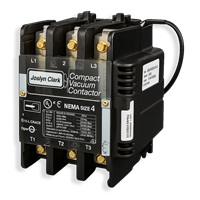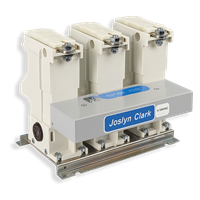Coal pulverizers, stone crushers, and longwall shearers are a few examples of heavy-duty applications in especially challenging environments where maintenance is dangerous and costly. It is important to maximize the up time of such industrial equipment by evenly dispersing wear and tear to its components. Many heavy-duty applications require reversing vacuum contactors to help control the machinery. For example, reversing vacuum contactors reverse the spin of the motor and, therefore the equipment, at fixed time intervals to allow even wear of components within coal crushers.
What is a Reversing Vacuum Contactor?
To apply reversing vacuum contactors means to have one contactor dedicated to spinning a three phase motor in one direction with a second contactor dedicated to spinning the same three phase motor in the opposite direction. Some areas of caution that should be evaluated and investigated when applying a vacuum contactor are:
- That adequate short circuit protection is provided for the contactor.
- The risk of shoot through current on the reverse phase of the contactor is prevented.

Short Circuit Protection for Vacuum Contactors
Expanding on point 1 above, the vacuum contactor is not a circuit breaker. It has a limited current interrupt capability and must always be protected by an adequately rated short circuit protection device, either in form of fuses or a circuit breaker. Heavy-duty applications are often fed from electrical systems with short circuit levels well in excess of a vacuum contactors interrupt capability, which are typically between 4,000 and 6,000 amps. If a short circuit occurs, the fault current must be cleared by the short circuit protection device and not the contactor.
In a reversing contactor application, there is line voltage constantly applied across two poles of the idle contactor. When switching motor rotation (reversing), a time delay must be present between opening the first contactor and closing the second. This delay provides time for the current and resulting arc to fully extinguish and any remaining gases to dissipate from the vacuum interrupter before line voltage is reapplied across its now open contacts. If a vacuum contactor pair is reversed too quickly, and line voltage is re-applied across the contact too quickly, residual gases in the interrupter re-ignite. The combination will create a fault, short circuiting the utility line. The risk of a short circuit occurring is much greater on a reverser circuit than on a conventional, full voltage, across the-line type starter.
Mechanically interlocked vacuum contactors prevent the contactor that is open from closing while the other contactor is fully closed. For example, if the “forward” contactor is closed, then the “reverse” contactor is mechanically blocked, preventing it from closing. The mechanical interlock provides this condition; however, when the “forward” contactor starts to open and may only be half open, mechanical interlock designs can allow the “reverse” contactor to start closing.
Because of the small gaps that are involved with vacuum contactors, typically contact gaps are 0.070” to 0.120” (1.75 to 3 mm), and gasses released from contact arcing as well as arc extinguishing times involved, one can see that the risk of a short circuit occurring by the operator pushing the forward-reverse control buttons rapidly, or using a joy stick control switch rapidly, on the “forward” phase is increased. Good practices in the design of reversing control schemes will ensure that this risk is minimized by the addition adequate electrical control circuit interlocking.
Preventing Shoot Through Current
Expanding on point 2 above, the control schemes should be developed to protect against an operator making rapid reversals and reduce the risk of a shoot through current described above. This risk is not only increased when a rapid reversal is attempted, but there is no control regarding how many rapid reversals would be attempted, say in a 60 second period. The more frequent attempts that are made with AC4 switching will increase the risk of temporarily reducing the dielectric strength of the vacuum interrupter. This increases the risk of shoot through current.
This is a difficult phenomenon to control but if good short circuit protection has been applied as in explanation 1 above, then the result would be nuisance tripping of the fuses or circuit breaker. Inadequate short circuit protection will result in damage to the vacuum interrupter which would result in downtime to repair and replace vacuum interrupters or the entire contactor. To ensure such nuisance tripping or damage does not occur, a more robust electrical interlock should be added.
A typical electrical interlock will use auxiliary contacts of the opposite direction contactor to ensure the pull in circuit cannot be energized while the other contactor is closed. This, however, needs to be taken a step further with a vacuum contactor providing a time delay of at least 0.5 seconds giving the opening contactor 1) time to fully open, 2) time for the plasma arc created by the contacts parting to extinguish, and 3) time for gasses released form the arcing to dissipate, allowing the vacuum inside the interrupter to regain its full dielelectric strength.
Applications such as crane control, stone crushers, longwall shearers and are some of the toughest applications that a contactor can be applied to. With a well-planned preventative maintenance program, correctly installed short circuit protection, an adequate control scheme, and operators understanding the care needed to operate this equipment, the user will be able to enjoy full advantages that reversing vacuum contactors offer and see a 95% reduction in downtime of ongoing cost of using equivalent air break devices.
How to specify vacuum contactors for high altitude environments
What are switching transients and how to minimize them with vacuum contactors
CV Series Compact Vacuum Contactor
Joslyn Clark’s Compact CV Series Vacuum Contactors and Starters are ideal for tough industrial applications. The compact design provides flexibility for retrofitting air break contactors, thus enabling an existing application to continue with maintenance cost and down time eliminated. Voltage raging from 600V to 1500KV and current ratings up to 600A are available.Learn more »
MVC Series Medium Voltage Vacuum Contactor
The Joslyn Clark USAVAC medium voltage vacuum contactors are 3-phase motor contactors built for control and protection in medium voltage applications ranging from 2300V to 7200V. Current ratings of 200-1200 ampere, and motor ratings up to 7000 HP at 6600V are available.Learn more »




